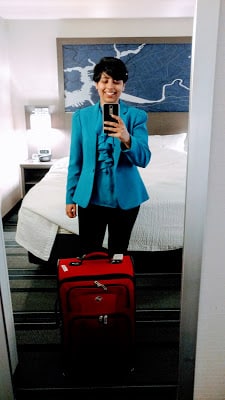|
Getting your Trinity Audio player ready…
|
Sending out postdoc applications and some of them require a cover letter?
Been there. I will keep it real as always and share with you the cover letter I wrote for a postdoc application at MIT – where I got the interview and had loads of fun visiting!
Mirror selfie at the hotel before my interview. It was February and I was COLD in just that jacket. Don’t take Boston lightly. Everrrr.
At the end of this post, I have pasted the cover letter as I submitted it.
I changed the font to match the font of this post, that’s all.
You are welcome to copy what I have provided below and paste it into a new Word document, then make changes as needed.
In other words, use the cover letter below as a template!
The format I have used is pretty standard.
Your name in huge letters at the top.
Then your work address, phone number, and email in the next line.
Then the date you are submitting it followed by the name of the professor who is hiring, her title, and work address.
If you do not know the name of the professor who is hiring then stop right here and find that out!
Then you start the letter and it should be no more than a few powerful paragraphs.
Don’t make any paragraph too big of a block of text.
In the very first sentence, you should say what you are writing them for, that is, to apply for a position.
Be specific. Say which position with what project.
Then say who you are.
Follow this up with when you will be graduating and when you can start the position.
Finish the paragraph with a strong statement about why you are more than perfect for the job.
The next paragraph is all about elaborating why you are perfect for the role.
Elaborate away but as succinctly as you can.
Any experience you speak about should be RELEVANT to the particular role you are applying for.
Keyword: relevant.
No one cares about the other stuff you know.
The professor(s) will KNOW if you are just sending them a generic cover letter that you send to every other school just with the school’s name changed.
Trust me, they know.
It takes work and time to make sure each cover letter is perfect for that particular role.
I applied to only 5 places!
I know. Crazy. But I got interviews at ALL but one place.
If you are not writing a cover letter specifically for a given role – you should really ask yourself if you even care enough to bother applying for that role.
This is what I did and ended up applying to so few places.
The truth is I don’t care about everything and that’s a good thing.
The third paragraph should be like a very short research statement – packed with strong statements about what it is you’d like to do and why the role is well-aligned with your goals.
Mention achievements that are, again, relevant to the position.
It is nice to put a big achievement near the end so you are leaving them with a reminder that you are an absolute goddess.
I always end by asking them to kindly consider the application and that I look forward to hearing from them – which is pretty standard.
Good luck on the postdoc apps and please comment below if you found this useful.
*******************************
howtophd
191 W Woodruff Ave, Columbus, OH 43210 | 614-XXX-XXXX | ********@gmail.com
Dec 1, 2017
Prof. Xxxxx Yyyyyy
Assistant Professor of Physics
Massachusetts Institute of Technology
77 Massachusetts Avenue
Cambridge, MA 02139-4307
Dear Prof. Xxxxx Yyyyyy:
I am applying for the postdoctoral position available in your laboratory for the GAPS project. I am currently a Ph.D. candidate in Physics at Ohio State University, advised by Prof. Amy Connolly. I will be graduating in May of 2018 and available to start this position thereafter. Due to my experience building and deploying the fourth mission of the Antarctic Impulsive Transient Antenna (ANITA-IV), I am well placed to make strong contributions to detector development, testing, calibration and deployment of the GAPS mission scheduled for flight in 2020.
Working on the ANITA project for my Ph.D. has given me the opportunity to develop strengths and skills that are transferable and relevant to a long-duration balloon experiment in the particle astrophysics field such as GAPS. For the ANITA-IV mission, I have played a leading role in the development, testing and commissioning of new hardware and electronics, ensuring a timely launch during an early onset of the polar vortex and remotely operating mission-critical electronics on the payload during its flight. I was deployed in Antarctica for two months, including a month prior to launch and a month post-launch. I gained experience working in the unique environment of the NASA LDB facility on Ross Island and succeeded in combating the challenges of a balloon experiment.
This postdoctoral position would be an excellent opportunity to contribute to the development and commissioning of silicon detectors which are at the heart of the GAPS instrument. This is well-aligned with my interest in learning new detection techniques and in making contributions that are critical to the GAPS project and the physics it is trying to probe. My work on the ANITA-IV instrument led to almost tripling the livetime of the experiment, as described in the pre-print found at https://arxiv.org/abs/1709.04536 and currently under review by Nuclear Instruments and Methods A. I wrote this paper as the corresponding author on behalf of the ANITA collaboration. I would strive to achieve success of similar or greater magnitude for the GAPS project.
Kindly consider my application for this postdoctoral position. Thank you for your time and I look forward to hearing back from you at your convenience.
Sincerely,
howtophd


Leave a Reply